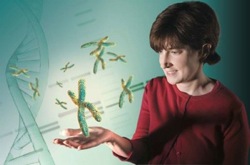About The Website

This website is a tool with educational sections to help you learn about the genetics of breast cancer and genetic testing. It presents the benefits and risks of getting tested for breast cancer risk in six educational modules developed by expert health care professionals in the field. To learn more, visit the Educational Modules link on the left.
Introduction

Each year, over 180,000 American women learn they have breast cancer. The chances of getting breast cancer are higher among women whose close blood relatives (such as a mother or sister) have had the disease. In addition, certain genes have been identified that increase one's risk of developing breast and other forms of cancer. This site is designed for those interested in learning more about the genetics of breast cancer and whether genetics testing is an appropriate option to consider. The website is interactive, featuring an assessment tool that gives you personalized risk information to help you to make informed decisions regarding breast cancer health care options.
What Does the Tree Represent?

The tree image represents our belief that a true understanding of breast cancer genetics requires a strong foundation of knowledge before branching out to other topics. You can think of learning about cancer and genetics like climbing a tree. You start first at the tree trunk with the basics, before moving up to other sections. We recommend that you start with Basic Genetics and then climb up to Cancer and Genetics. These sections provide key facts about breast cancer and genetics. After you learn about Basic Genetics and Cancer and Genetics, you can branch out to other sections.
Using The Website
Click on the blue links to see the different sections. You may want to start at the top and work your way down, reading the materials in order so you don't miss anything. Any word shown in green and italics is a glossary term. Place your mouse over any glossary term to see a more in depth definition of that term.
Acknowledgements
This site was developed with grants from the University of Michigan (U-M) Comprehensive Cancer Center and Center of Excellence in Cancer Communication Research (Scott Roberts, PI). Special thanks to Kara Milliron and Sofia Merajver of the U-M Breast & Ovarian Cancer Risk Evaluation Program for their support and contributions.
